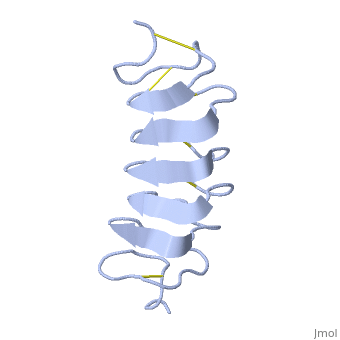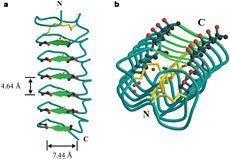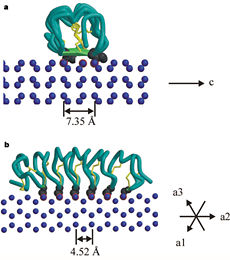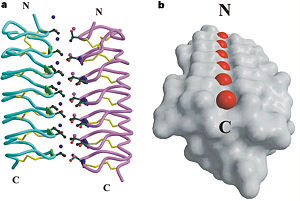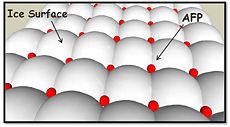Tenebrio molitor Antifreeze Protein (TmAFP)
From Proteopedia
(Difference between revisions)
| Line 5: | Line 5: | ||
Antifreeze proteins (AFPs) are produced by certain vertebrates, plants, fungi and bacteria that permit their survival in subzero environments. AFPs bind to ice crystals to inhibit growth of ice that would otherwise be fatal to those organisms. | Antifreeze proteins (AFPs) are produced by certain vertebrates, plants, fungi and bacteria that permit their survival in subzero environments. AFPs bind to ice crystals to inhibit growth of ice that would otherwise be fatal to those organisms. | ||
| - | AFPs are classified | + | AFPs are classified into two groups on the basis of their activity (Thermal Hysteresis or TH, see below in Function), moderate and hyperactive AFPs. |
| - | Moderate AFP's usually originate from fish that live in the polar area in which the temperature can be low as -2 | + | Moderate AFP's usually originate from fish that live in the polar area in which the water temperature can be low as -2 degrees Celsius . |
Hyperactive AFP usually originate from insects (but recently have been discovered in other organisms including bacteria) that live in areas where the temperature is much lower and can be as low as -40 Celsius degrees. | Hyperactive AFP usually originate from insects (but recently have been discovered in other organisms including bacteria) that live in areas where the temperature is much lower and can be as low as -40 Celsius degrees. | ||
.<ref>DOI doi:10.1016/j.cryobiol.2006.06.006</ref> | .<ref>DOI doi:10.1016/j.cryobiol.2006.06.006</ref> | ||
| - | ''Tm''AFP is a hyperactive antifreeze protein and its origin is the Tenebrio | + | ''Tm''AFP is a hyperactive antifreeze protein and its origin is the Tenebrio Molitor beetle (Mealworm). These beetles are found in dark and very cold areas such as the polar region. Due to ''Tm''AFP, the Tenebrio Molitor beetle is freezing tolerant which provides protection against physical and osmotic stresses. ''Tm''AFP is shaped like a slightly flattened cylinder 32Å in length, and 6.5X 14Å in the pseudo,rectangular cross section and is one of the smallest Beta Hellix AFP known to date. |
This is a <scene name='61/612804/Rainbow/1'>Rainbow</scene> view of the protein presenting the N terminal in blue and the C terminal in red. | This is a <scene name='61/612804/Rainbow/1'>Rainbow</scene> view of the protein presenting the N terminal in blue and the C terminal in red. | ||
| Line 17: | Line 17: | ||
The protein consists of 84 amino acids and the molecular weight is 8.4 kDA. | The protein consists of 84 amino acids and the molecular weight is 8.4 kDA. | ||
| - | ''Tm''AFP is protein rich of Threonine and Cystein | + | ''Tm''AFP is protein rich of Threonine and Cystein and forms a regular parallel beta-helix. It is composed of 7 tandem repeats which consist of 12 amino acids (TCTxSxxCxxAx). <scene name='61/612804/Tct/1'>TCT </scene> or ACT (<span style="color:purple;background-color:white;font-weight:bold;">Thr</span>, <span style="color:purple;background-color:white;font-weight:bold;">Cys</span>, <span style="color:purple;background-color:white;font-weight:bold;">Thr</span>) motifs are aligned to form a <scene name='61/612804/Beta_sheet/2'>flat Beta sheet</scene> along one side of the molecule the Beta sheets right handed which are the binding site of the protein.<ref name="one">DOI 10.1529/biophysj.104.051169</ref> The rest of the tandem repeat forms the loop which enables a very organized structure of the protein. Cysteine all over the tandem repeats, are pared to provide the <scene name='61/612804/Cys/1'>disulphid bonds</scene> which contribute to the stability of the protein. Six of the eight disulphide bounds construct near perfect alignment enables appropriate structure that allows binding to the ice lattice. The other <scene name='61/612804/2disulphide/1'>two disulphide bonds</scene> in the N-terminal region do not fit this pattern and involved in a capping structure. The extraordinary tightness of the 12 amino-acids turn is also facilitated by intra-loop <scene name='61/612804/Hbond/2'>hydrogen bond</scene> connections between backbone CO and NH groups. |
[[Image:406322aa.2.jpg|230px|right]] | [[Image:406322aa.2.jpg|230px|right]] | ||
''Tm''AFP is the one of smallest Beta-Helix with only 12 amino acids per turn. Therefore, it has a very narrow bore, which is constricted and further bisected by disulphide bonds to form two channels, leaving no room for hydrophobic core. The few Hydrophobic residues <scene name='61/612804/Hydrophobic/2'>val25, val34, phe58, tyr70</scene> have their side chains projecting outwards to the solvent. In the core there is room only for the relatively small side chains of the conserves Serine and Alanine to project into the core, on either side of the bisecting disulphide bridge.<ref name="two">DOI 10.1038/35018604</ref> | ''Tm''AFP is the one of smallest Beta-Helix with only 12 amino acids per turn. Therefore, it has a very narrow bore, which is constricted and further bisected by disulphide bonds to form two channels, leaving no room for hydrophobic core. The few Hydrophobic residues <scene name='61/612804/Hydrophobic/2'>val25, val34, phe58, tyr70</scene> have their side chains projecting outwards to the solvent. In the core there is room only for the relatively small side chains of the conserves Serine and Alanine to project into the core, on either side of the bisecting disulphide bridge.<ref name="two">DOI 10.1038/35018604</ref> | ||
Revision as of 15:41, 25 January 2015
| |||||||||||
References
- ↑ Scotter AJ, Marshall CB, Graham LA, Gilbert JA, Garnham CP, Davies PL. The basis for hyperactivity of antifreeze proteins. Cryobiology. 2006 Oct;53(2):229-39. Epub 2006 Aug 2. PMID:16887111 doi:http://dx.doi.org/10.1016/j.cryobiol.2006.06.006
- ↑ Liu K, Jia Z, Chen G, Tung C, Liu R. Systematic size study of an insect antifreeze protein and its interaction with ice. Biophys J. 2005 Feb;88(2):953-8. PMID:15713600 doi:http://dx.doi.org/10.1529/biophysj.104.051169
- ↑ 3.0 3.1 Liou YC, Tocilj A, Davies PL, Jia Z. Mimicry of ice structure by surface hydroxyls and water of a beta-helix antifreeze protein. Nature. 2000 Jul 20;406(6793):322-4. PMID:10917536 doi:10.1038/35018604
- ↑ doi: https://dx.doi.org/10.1016/S0968-0004(01)02028-X
